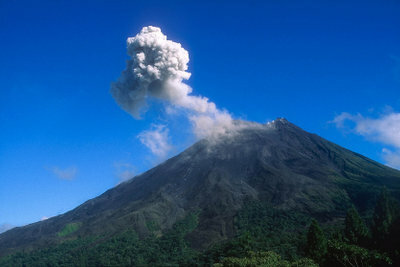Volcanic eruption and its effects
A volcanic eruption can have devastating effects, not only for climate change, but especially for the inhabitants of vulnerable volcanic areas. Geological investigations with seismographs enable z. T. to analyze the earth tremors accordingly in order to be able to predict the probability of a volcanic eruption.

A volcanic eruption can be different
- More than 102 different areas of the world are considered volcanic areas. In Europe are z. B. Mount Etna (Sicily), Beerenberg (Norway), Brennisteinsalda (Iceland), Capelinhos (Portugal, Eyjafjallajökull (Iceland) and Vesuvius (Italy) are known as active volcanoes. Within Germany, the areas of the Vulkaneifel, Hohen Eifel, Westerwald, Rhön, Vogelsberg u. a. as volcanic areas.
- A volcanic eruption is in Germany Although less to be suspected, the earthquakes around the Cologne Bay and Rheingraben prove that volcanism is not yet completely over. A distinction is made between active and inactive volcanoes and it is hoped that the centuries of inactivity of the volcanoes will remain within Germany.
- If glowing magma penetrates the surface of the earth, it can escape explosively through an opening in the earth, so that the surrounding area cools down to rock within many square kilometers. This explosion is called a volcanic eruption, which has devastating effects, especially for the residents of the endangered areas. After an eruption, a visible opening in the earth remains, which appears as a volcanic cone or Is called volcanic dome.
- Depending on the shape, location and activity of a volcano and how the magma is supplied to the volcano, geologists differentiate between different volcanoes such as B. the stratovolcano, slag volcano or table volcano. The terms "central volcano" or "crevice volcano" explain that the magma feed is different. A central volcano develops over many hundreds of thousands of years through various magma chambers that form a central volcanic building (e. B. a mountain or hill).
- A crevasse volcano does not (yet) have a central way out. B. Ridges. In some cases, rows of craters can form. It is fatal that a volcanic eruption does not follow a certain pattern and, despite seismographs, it is never possible to predict with one hundred percent when it will erupt. Inside the earth, at a depth of around 100 km, temperatures between 1000 and 1300 degrees Celsius prevail, so that rocks melt into magma. If the pressure of the magma within its chambers becomes too great, it rises through fissures and crevices. Only when it reaches the surface of the earth is it referred to with the term "lava".
The pacific ring of fire - information about a crisis region
It is called the "Ring of Fire", the Pacific ring of fire. As the name indicates, …
Lava eruptions have devastating effects
- The volcanic eruption not only hurls viscous and glowing rocks and magma to the surface of the earth, but above all gases (sulfur gases). The pyroclastic (solid-gas-dispersion / mixture) currents are extremely hot and lethally spread over the surface of the earth. Fauna and flora are destroyed, which, in addition to the sulfur gases released, can lead to a global climate change.
- The approx. 300 - 800 ° C hot magma, which flows over the earth's surface as volcanic rock, can flow down the slope up to 400 kilometers per hour. These pyroclastic springs pulverize any object, any object that gets in their way. Research has shown that even the dust and ashes of the erupting lava are deadly.
- Geologists try to control volcanoes, volcanic eruptions, and earthquakes with seismographs, but as mentioned earlier, predictions about a volcanic eruption are difficult to predict. People who live in endangered areas are therefore warned of even small earthquakes and, if necessary, evacuated if the seismographic values are too high. However, this is less well known in Germany. In the particularly endangered areas, evacuations result in high costs. Therefore, geologists try to be able to forecast as precisely as possible.
- Active volcanoes and volcanic eruptions not only influence the personal and economic fate of the people affected population, but affect the entire infrastructure of the affected regions. Geologists use five different methods to monitor volcanoes: seismographic, geodetic Testing of suction height, temperature measurements, chemical analysis and measurement of magnetic Changes. Nevertheless, volcanic eruptions always remain unpredictable. In an emergency, it may be advisable to observe the behavior of the animals, which react sensitively and leave endangered areas.
How helpful do you find this article?

